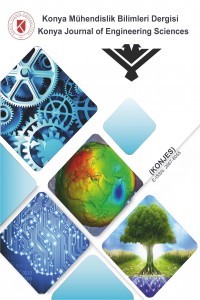Düşük Enerji Seviyeli Kaynakla Çalışan Afyon Jeotermal Güç Santralinin Performans Değerlendirilmesi
Türkiye'nin batısındaki 2700 kW'lık binary jeotermal santralinin termoekonomik performans değerlendirmesive mevcut işletme verileri kullanılarak gerçekleştirilmiş ve potansiyel iyileştirmeler tespit edilmiştir.Afyon Jeotermal Santrali, elektrik üretiminde jeotermal enerjinin kullanımı için mevcut çalışmaparametrelerini kapsamlı bir şekilde kullanarak bilgisayar ortamında termodinamik olarak modellenmiştir.Santralin modellenmesinde termodinamik koşullar altında ekergoekonomik analiz için MühendislikDenklem Çözme (EES) yazılımı kullanılmıştır. Jeotermal suyun sıcaklığı ve kütlesel debisi sırasıyla 110°Cve 150 kg/s'dir. Santralin enerji ve ekserji verimliliği %10.4 ve %29.7 olarak hesaplanmıştır. Yıllık ortalamajeotermal elektrik geliri 2,880,277 $/yıl olarak hesaplanmaktadır. Santralden üretilen elektriğin ekserjetikmaliyeti ise 0.0233 $/kWh olarak hesaplanmaktadır.
Anahtar Kelimeler:
Jeotermal enerji santrali, termodinamik analiz, eksergoekonomik analiz
PERFORMANCE EVALUATION OF AFYON GEOTHERMAL POWER PLANT WITH LOW GRADE ENERGY SOURCES
Exergoeconomic performance evaluation of 2700 kW binary cycle design geothermal powerplant in western Turkey is conducted using actual plant operating data, and potential improvements areidentified. Afyon Geothermal Power Plant is thermodynamically modeled in a computer environmentusing current working parameters in a comprehensive way for the use of geothermal energy in electricitygeneration. To simulate the plant during thermodynamic conditions with exergoeconomic analysis, theEngineering Equation Solver (EES) software is used. Geothermal water temperature and mass flow rateof the plant are 110°C, and 150 kg/s, respectively. Energy and exergy efficiencies of the plant are calculatedas 10.4%, and 29.7%. The potential annual revenue of geothermal electricity is calculated to be 2,880,277$/yr. The exergetic cost of the electricity from the plant is calculated as 0.0233 $/kWh, respectively.
___
- Abusoglu A., Kanoglu M., 2008. First and second law analysis of diesel engine powered cogeneration systems. Energy Conversion and Management49(8), 2026-2031.
- Aksoy N., 2014. Power generation from geothermal resources in Turkey. Renewable Energy68, 595-601. Aspen Plus. Version 8.4, 2015. Aspen Technology Incorporated., Ten Canal Park, Cambridge, MA, USA. www.aspentech.com.
- Balcilar M., Ozdemir Z.A., Ozdemir H., Shahbaz M., 2018. The renewable energy consumption and growth in the G-7 countries: Evidence from historical decomposition method. Renewable Energy126, 594-604.
- Bejan A., Tsatsaronis G., Moran M. J., 1996. Thermal design and optimization. John Wiley & Sons.
- Bina, S. M., Jalilinasrabady, S., & Fujii, H., 2018. Exergoeconomic analysis and optimization of single and double flash cycles for Sabalan geothermal power plant. Geothermics 72, 74-82.
- DiPippo R., 2007. Ideal thermal efficiency for geothermal binary plants. Geothermics36(3), 276-285.
- Ergun A., Ozkaymak M., Aksoy Koc G., Ozkan S., Kaya D., 2017. Exergoeconomic analysis of a geothermal organic Rankine cycle power plant using the SPECO method. Environmental Progress & Sustainable Energy 36(3), 936-942.
- F-Chart Software, EES, engineering equation solver. In: F-Chart Software, 2015. Inter-net Website, www.fchart.com/ees/ees.shtml
- Heberle F., Hofer M., Ürlings N., Schröder H., Anderlohr T., Brüggemann D., 2017. Techno-economic analysis of a solar thermal retrofit for an air-cooled geothermal Organic Rankine Cycle power plant. Renewable Energy 113, 494-502.
- Hanbury O., Vasquez V.R., 2018. Life cycle analysis of geothermal energy for power and transportation: A stochastic approach. Renewable Energy115, 371-381.
- Kanoglu M., 2002. Exergy analysis of a dual-level binary geothermal power plant. Geothermics 31(6), 709- 724.
- Kanoglu M., Dincer I., 2009. Performance assessment of cogeneration plants. energy conversion and management 50(1), 76-81.
- Karadas M., Celik H.M., Serpen U., Toksoy M., 2015. Multiple regression analysis of performance parameters of a binary cycle geothermal power plant. Geothermics 54, 68-75.
- Kasaei M.J., Gandomkar M., Nikoukar J., 2017. Optimal management of renewable energy sources by virtual power plant. Renewable Energy 114, 1180-1188.
- Kolahi M.R., Nemati A., Yari M., 2018. Performance optimization and improvement of a flash-binary geothermal power plant using zeotropic mixtures with PSO algorithm. Geothermics 74, 45-56.
- Koroneos C., Polyzakis A., Xydis G., Stylos N., Nanaki E., 2017. Exergy analysis for a proposed binary geothermal power plant in Nisyros Island, Greece. Geothermics 70, 38-46.
- Rachmat, A., Wibowo, A. S., & Surachman, A., 2018, January. Exergoeconomic analysis and optimization of a combined double flash–binary cycle for Ulubelu geothermal power plant in Indonesia. In IOP Conference Series: Earth and Environmental Science (Vol. 105, No. 1, p. 012087). IOP Publishing.
- Sahin C., 2016. Electricity Generation with Organic Rankine Cycle (Orc)In Low Temperature Geothermal Field and Modelling of AfyonGeothermal Electric Production Co., Electrical and Electronics Engineering, M.S. Thesis.
- Shokati N., Ranjbar F., Yari M., 2015. Exergoeconomic analysis and optimization of basic, dual-pressure and dual-fluid ORCs and Kalina geothermal power plants: A comparative study. Renewable Energy 83, 527-542.
- Unverdi, M., and Cerci, Y., 2013. Performance analysis of Germencik geothermal power plant. Energy 52, 192-200.
- Wang J., Wang J., Dai Y., Zhao P., 2015. Thermodynamic analysis and optimization of a flash-binary geothermal power generation system. Geothermics, 55, 69-77.
- Yari M., 2010. Exergetic analysis of various types of geothermal power plants. Renewable Energy 35(1), 112-121.
- Yilmaz C., 2017. Thermodynamic and economic investigation of geothermal powered absorption cooling system for buildings. Geothermics70, 239-248.
- Zare, V., 2015. A comparative exergoeconomic analysis of different ORC configurations for binary geothermal power plants. Energy Conversion and Management 105, 127–138.
- Yayın Aralığı: Yılda 4 Sayı
- Başlangıç: 2004
- Yayıncı: Konya Teknik Üniversitesi
Sayıdaki Diğer Makaleler
GÖRÜNTÜ İŞLEME VE YAPAY SİNİR AĞLARI İLE İLETİM HATLARINDA ARIZA YERİ BELİRLEME
EĞİK ÇATLAK İÇEREN ÇELİK PLAKANIN YORULMA DAVRANIŞININ FARKLI HASAR MODELLERİYLE TAHMİNİ
Necla Seval ERDEM, Ahmet Vefa ORHON
Karışık Talep Bilgisi Kapsamında Toplu Sipariş Envanter Yönetimi: Bir Durum Çalışması
Muzaffer ALIM, Patrick BEULLENS
MooDetecTR: Kelime Vektörleri Vasıtasıyla Türkçe Şarkı Sözleri için Ruh Hali Tespiti
Barış ÇİMEN, Ahmet Onur DURAHİM
ENDÜKTİF KUPLAJLI RFID’NİN TASARIM ESASLARI VE ARDUİNOLU BİR UYGULAMASI
Moleküler Potansiyel Enerji Fonksiyonu İçin Geliştirilmiş Sosyal Örümcek Algoritması
DÜŞÜK MALİYET VE YÜKSEK ENERJİ TASARRUFUNA SAHİP TERMAL BOYA ÜRETİMİ
